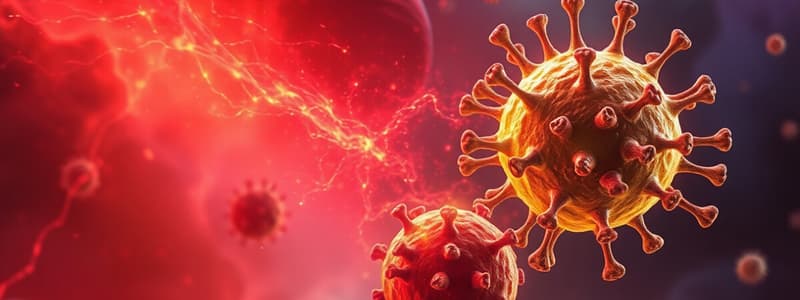Podcast
Questions and Answers
What is the role of pyrogens in the development of a fever?
What is the role of pyrogens in the development of a fever?
- Pyrogens are released by pathogens to weaken the immune system.
- Pyrogens directly attack and destroy pathogens.
- Pyrogens signal the body to increase its temperature by acting on the hypothalamus. (correct)
- Pyrogens are responsible for the physical symptoms of fever, such as chills and sweating.
When does a fever become a cause for concern, requiring medical attention?
When does a fever become a cause for concern, requiring medical attention?
- When the fever persists despite taking medication. (correct)
- When the fever rises above 100 degrees Fahrenheit.
- When the fever lasts for more than 24 hours.
- When the fever is accompanied by a cough.
How does fever potentially help the body fight off infections?
How does fever potentially help the body fight off infections?
- Fever inhibits the growth and reproduction of some pathogens. (correct)
- Fever stimulates the production of antibodies, which directly attack pathogens.
- Fever decreases the body's metabolic rate, conserving energy for fighting infection.
- Fever weakens the immune system, making it easier for the body to fight off infections.
What is the primary reason for seeking medical attention for a fever?
What is the primary reason for seeking medical attention for a fever?
Which of the following is NOT a characteristic of a fever?
Which of the following is NOT a characteristic of a fever?
Flashcards
Fever
Fever
An elevation of body temperature as a defense against infection.
Pyrogens
Pyrogens
Chemicals released by the immune system that induce fever.
Hypothalamus
Hypothalamus
Brain region that regulates body temperature and responds to pyrogens.
Infection Defense
Infection Defense
Signup and view all the flashcards
Consult a Doctor
Consult a Doctor
Signup and view all the flashcards
Study Notes
Fever: A Protective Response
- Fever, also known as pyrexia, is a core aspect of the body's natural defense system against infections.
- It is an elevation of the body's normal temperature, typically exceeding 99.6 degrees Fahrenheit when measured orally or 100.4 degrees Fahrenheit rectally.
- Fever results from the body's fight against pathogens, like bacteria, fungi, and viruses, that invade and damage cells.
- The immune system releases chemicals called pyrogens that travel to the hypothalamus, the brain region responsible for regulating temperature.
- Pyrogens bind to specific receptors in the hypothalamus, triggering an elevation of body temperature.
- This temperature increase is believed to be a crucial strategy for killing off pathogens that are sensitive to temperature changes.
Importance of Consulting a Doctor
- While fever is a natural defense mechanism, a persistent fever warrants immediate medical attention.
- A doctor can accurately assess the cause of the fever and recommend appropriate treatment.
Studying That Suits You
Use AI to generate personalized quizzes and flashcards to suit your learning preferences.




